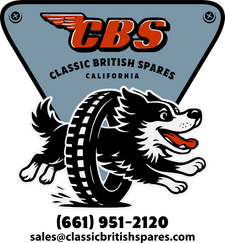
Tech Tip: Fixing Loose Clutch Hub Screws
Have you ever read about the those 6 small screws that retain your clutch hub center (and rubbers) working loose inside your primary?
Some of you may have, and chances are some of you haven't...
Today I wanted to cover an original BSA Service Bulletin dated from the 1960's that offers some basic info on how to retain those pesky little screws from working loose
I will also cover some tips on what I like to do here at the shop that is not shown in the BSA Service Bulletin
The info we are covering is for both 3-spring clutches and most 4-spring clutches on both Triumph & BSA applications
Lets dive in..
Clutch hub assembly
There where a few types of clutch assembly's fitted to both Triumph & BSA models (unit and pre-unit) with the popular 3-spring and early style 4-spring clutch
Although slightly different, they are very similar in the parts they use, design and functionality
The clutch hub assembly is located inside your primary cover and mounted on the mainshaft by a taper fit
Internally the hub consists of shock rubbers, a spider, retaining plates, 6 screws (some use bolts) and a center sleeve
To retain all the internal hub parts listed above, the outside screws must be tight and secure to allow a properly functioning clutch
If all is done properly, you should have a reliable and secure clutch hub assembly
The problem

Now that you understand the basic role of the clutch hub assembly, lets cover the real problem
The screws that retain the front and back plates are typically a counter-sunk style single slot screw that is threaded into the center housing of the hub
Without properly tightening down the screws they could work loose
When this situation happens, you could be left with an undesirable clutch action
Not to mention that you should not have any loose screws "floating" inside your clutch and primary area as that could be catastrophic
BSA Service Bulletin (The solution)
Click on the image to above to enlarge (you can also print, share, and save)
The BSA Service Bulletin shown above was sent out to both west & east coast dealers that showcase the loose screws problem while offering a simple solution
According to the bulletin, BSA suggested that each dealer (or mechanic) use a small dab of Loctite to retain each screw while ensuring that each of the 6 screws are tight, evenly
For those questioning "which Loctite should I use?" - blue Loctite should be employed as your first choice of thread locking sealant as red sealant may be too difficult to remove upon future disassembly
Modification & tips
While I do agree that Loctite does in fact work, I like to go the extra mile to ensure that each screw is tight and will not back out
The modification I like to do on all of my clutch hubs for both road use and racing consists of drilling a counterbore and peening over the countersunk screw to prevent it from backing out
By adding a counterbore the screw head now has a "valley" which will allow the head to be deformed in the divot once peened over
For this modification you will need a mill or drill press, drill center and a vice (or clamp)
I take and mount each plate (front & back) on my milling table to make sure we have a rigid and stable set up
For this set-up, I’ll clamp my hub into my Kurt vise

From there I insert my drill center and find the location I want to perform the counterbore which would be right on the edge of where the countersunk bore begins
A few "pecks" and the hole is ready

When you are done, insert your screw and make sure it is tight
From there you can peen over the screw head and it should look like the photo above
Now you can feel confident that the small screws are tight and secure
Replacement parts
Should you be in a position to rebuild your clutch hub or you are seeking basic replacement parts please checkout some of the following links in the chart below..
| Part Type | Link |
| Clutch Hub Rubbers (57-1722/3) | Click Here |
| Clutch Screws (57-1040) | Click Here |
| Complete Clutch Hub (3-Spring) | Click Here |
| Complete Clutch Hub (4-Spring) | Click Here |
Thanks for reading
Thank you for reading today's new Tech Tip post!
Like what you read? Click here to read more posts like the one above
Have something to say? - Feel free to leave us a comment in the section below
Ride safe!


mark parker
I just drill them through braze a nut on the back plate and use H/tensile bolts going right through with locktite, or you can rivet the end a bit, though there is limited space. You can always grind it off to undo them. I know the plate is hardened but brazing doesn’t seem to effect how long they last.
Classic British Spares
Thanks for reading!
KickStart
Lacking a mill or drill press to create a divot, a person may also simply center punch the edge with a sharp tool. That method for countersunk screws has been used successfully for decades.
Ian Rounsevell
Very practical & helpfull